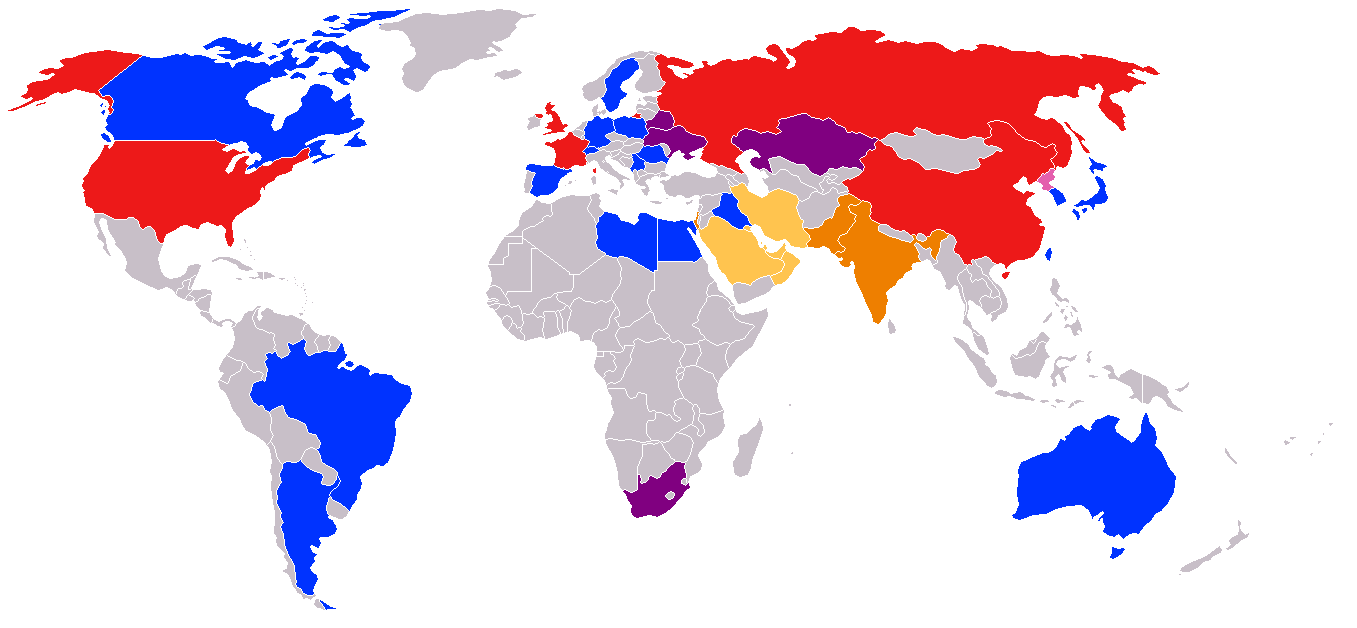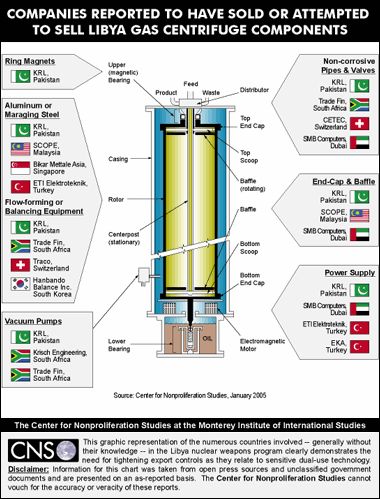16: Nuclear Proliferation
- Page ID
- 19591
\( \newcommand{\vecs}[1]{\overset { \scriptstyle \rightharpoonup} {\mathbf{#1}} } \)
\( \newcommand{\vecd}[1]{\overset{-\!-\!\rightharpoonup}{\vphantom{a}\smash {#1}}} \)
\( \newcommand{\id}{\mathrm{id}}\) \( \newcommand{\Span}{\mathrm{span}}\)
( \newcommand{\kernel}{\mathrm{null}\,}\) \( \newcommand{\range}{\mathrm{range}\,}\)
\( \newcommand{\RealPart}{\mathrm{Re}}\) \( \newcommand{\ImaginaryPart}{\mathrm{Im}}\)
\( \newcommand{\Argument}{\mathrm{Arg}}\) \( \newcommand{\norm}[1]{\| #1 \|}\)
\( \newcommand{\inner}[2]{\langle #1, #2 \rangle}\)
\( \newcommand{\Span}{\mathrm{span}}\)
\( \newcommand{\id}{\mathrm{id}}\)
\( \newcommand{\Span}{\mathrm{span}}\)
\( \newcommand{\kernel}{\mathrm{null}\,}\)
\( \newcommand{\range}{\mathrm{range}\,}\)
\( \newcommand{\RealPart}{\mathrm{Re}}\)
\( \newcommand{\ImaginaryPart}{\mathrm{Im}}\)
\( \newcommand{\Argument}{\mathrm{Arg}}\)
\( \newcommand{\norm}[1]{\| #1 \|}\)
\( \newcommand{\inner}[2]{\langle #1, #2 \rangle}\)
\( \newcommand{\Span}{\mathrm{span}}\) \( \newcommand{\AA}{\unicode[.8,0]{x212B}}\)
\( \newcommand{\vectorA}[1]{\vec{#1}} % arrow\)
\( \newcommand{\vectorAt}[1]{\vec{\text{#1}}} % arrow\)
\( \newcommand{\vectorB}[1]{\overset { \scriptstyle \rightharpoonup} {\mathbf{#1}} } \)
\( \newcommand{\vectorC}[1]{\textbf{#1}} \)
\( \newcommand{\vectorD}[1]{\overrightarrow{#1}} \)
\( \newcommand{\vectorDt}[1]{\overrightarrow{\text{#1}}} \)
\( \newcommand{\vectE}[1]{\overset{-\!-\!\rightharpoonup}{\vphantom{a}\smash{\mathbf {#1}}}} \)
\( \newcommand{\vecs}[1]{\overset { \scriptstyle \rightharpoonup} {\mathbf{#1}} } \)
\( \newcommand{\vecd}[1]{\overset{-\!-\!\rightharpoonup}{\vphantom{a}\smash {#1}}} \)
\(\newcommand{\avec}{\mathbf a}\) \(\newcommand{\bvec}{\mathbf b}\) \(\newcommand{\cvec}{\mathbf c}\) \(\newcommand{\dvec}{\mathbf d}\) \(\newcommand{\dtil}{\widetilde{\mathbf d}}\) \(\newcommand{\evec}{\mathbf e}\) \(\newcommand{\fvec}{\mathbf f}\) \(\newcommand{\nvec}{\mathbf n}\) \(\newcommand{\pvec}{\mathbf p}\) \(\newcommand{\qvec}{\mathbf q}\) \(\newcommand{\svec}{\mathbf s}\) \(\newcommand{\tvec}{\mathbf t}\) \(\newcommand{\uvec}{\mathbf u}\) \(\newcommand{\vvec}{\mathbf v}\) \(\newcommand{\wvec}{\mathbf w}\) \(\newcommand{\xvec}{\mathbf x}\) \(\newcommand{\yvec}{\mathbf y}\) \(\newcommand{\zvec}{\mathbf z}\) \(\newcommand{\rvec}{\mathbf r}\) \(\newcommand{\mvec}{\mathbf m}\) \(\newcommand{\zerovec}{\mathbf 0}\) \(\newcommand{\onevec}{\mathbf 1}\) \(\newcommand{\real}{\mathbb R}\) \(\newcommand{\twovec}[2]{\left[\begin{array}{r}#1 \\ #2 \end{array}\right]}\) \(\newcommand{\ctwovec}[2]{\left[\begin{array}{c}#1 \\ #2 \end{array}\right]}\) \(\newcommand{\threevec}[3]{\left[\begin{array}{r}#1 \\ #2 \\ #3 \end{array}\right]}\) \(\newcommand{\cthreevec}[3]{\left[\begin{array}{c}#1 \\ #2 \\ #3 \end{array}\right]}\) \(\newcommand{\fourvec}[4]{\left[\begin{array}{r}#1 \\ #2 \\ #3 \\ #4 \end{array}\right]}\) \(\newcommand{\cfourvec}[4]{\left[\begin{array}{c}#1 \\ #2 \\ #3 \\ #4 \end{array}\right]}\) \(\newcommand{\fivevec}[5]{\left[\begin{array}{r}#1 \\ #2 \\ #3 \\ #4 \\ #5 \\ \end{array}\right]}\) \(\newcommand{\cfivevec}[5]{\left[\begin{array}{c}#1 \\ #2 \\ #3 \\ #4 \\ #5 \\ \end{array}\right]}\) \(\newcommand{\mattwo}[4]{\left[\begin{array}{rr}#1 \amp #2 \\ #3 \amp #4 \\ \end{array}\right]}\) \(\newcommand{\laspan}[1]{\text{Span}\{#1\}}\) \(\newcommand{\bcal}{\cal B}\) \(\newcommand{\ccal}{\cal C}\) \(\newcommand{\scal}{\cal S}\) \(\newcommand{\wcal}{\cal W}\) \(\newcommand{\ecal}{\cal E}\) \(\newcommand{\coords}[2]{\left\{#1\right\}_{#2}}\) \(\newcommand{\gray}[1]{\color{gray}{#1}}\) \(\newcommand{\lgray}[1]{\color{lightgray}{#1}}\) \(\newcommand{\rank}{\operatorname{rank}}\) \(\newcommand{\row}{\text{Row}}\) \(\newcommand{\col}{\text{Col}}\) \(\renewcommand{\row}{\text{Row}}\) \(\newcommand{\nul}{\text{Nul}}\) \(\newcommand{\var}{\text{Var}}\) \(\newcommand{\corr}{\text{corr}}\) \(\newcommand{\len}[1]{\left|#1\right|}\) \(\newcommand{\bbar}{\overline{\bvec}}\) \(\newcommand{\bhat}{\widehat{\bvec}}\) \(\newcommand{\bperp}{\bvec^\perp}\) \(\newcommand{\xhat}{\widehat{\xvec}}\) \(\newcommand{\vhat}{\widehat{\vvec}}\) \(\newcommand{\uhat}{\widehat{\uvec}}\) \(\newcommand{\what}{\widehat{\wvec}}\) \(\newcommand{\Sighat}{\widehat{\Sigma}}\) \(\newcommand{\lt}{<}\) \(\newcommand{\gt}{>}\) \(\newcommand{\amp}{&}\) \(\definecolor{fillinmathshade}{gray}{0.9}\)Nuclear weapons have spread from nation to nation since the development of the first atomic bombs by the United States during World War II (Figure \(\PageIndex{1}\)). Eight countries currently possess these weapons along with Israel, which has never admitted possession but is thought to have a small arsenal (Table \(\PageIndex{1}\)). The primary motivations for a nation to obtain these weapons are fear of rival nations, international prestige, and national pride.

| Country | Program Initiated | First Weapon Tested | Current Number of Weapons (2009)* |
|---|---|---|---|
| United States | 1942 | 1945 | ~9,400 |
| Soviet Union/Russia | 1945 | 1949 | ~13,000 |
| United Kingdom | 1942 | 1952 | 185 |
| France | 1949 | 1960 | 300 |
| China | 1955 | 1964 | 240 |
| India | 1965 | 1974 | 60 |
| Pakistan | 1972 | 1998 | 60 |
| North Korea | 1971(?) | 2006 | <10 |
| Israel | 1952 | 1981(?) | 80 |
*Operational and stockpiled All numbers are estimates and are further described in the Nuclear Notebook in the Bulletin of the Atomic Scientists, and the nuclear appendix in the SIPRI Yearbook. Additional reports are published on the FAS Strategic Security Blog. Unlike those publications, this table is updated continuously as new information becomes available. Current update: April 2, 2009.
Since its inception in 1975, the Nuclear Non-proliferation Treaty (NPT) has helped to limit the number of nuclear armed nations to the five that possessed these weapons at the time it came into force (the United States, Russia, the United Kingdom, France, and China) along with four other nuclear states (India, Israel, Pakistan, and North Korea) that have refused to join the treaty. The NPT’s security framework formed the basis for diplomatic efforts that have led several states to abandon their nuclear weapons programs (Argentina, Brazil, Sweden, and Libya). They have also resulted in four nations giving up their nuclear weapons (South Africa, Belarus, Kazakhstan, and Ukraine). However, today uncertainty concerning the purpose of the nuclear program of Iran (a signatory of the NPT), the nuclear weapons program of North Korea (a country who withdrew from the NPT), and the recent nuclear agreement between the United States and India are challenging the treaty.

Among the responsibilities of the International Atomic Energy Agency (IAEA), created in 1957 as an agency of the United Nations, is that of assuring that the nuclear materials and activities of NPT signatory nations are not intended for military purposes. To this end, IAEA inspects and verifies nuclear facilities and activities in these countries. The agency has no enforcement powers but rather reports to the UN Security Council, which can then take action against violators. Twenty-one countries with civilian nuclear facilities have signed the NPT as non-nuclear-weapons states and have accepted IAEA inspections.
A nation seeking to produce nuclear weapons must complete the following basic steps:
- Develop a weapon design or obtain one from an external source.
- Produce highly enriched uranium or plutonium for the core of the device or obtain this material from an external source.
- Fabricate this material into the fissile component of the weapon.
- Fabricate or obtain from external sources the non-nuclear components of the weapon. These include high explosives and a triggering mechanism to detonate the nuclear core.
- Verify the reliability of all components individually and as a system.
- Assemble the components into a deliverable weapon (Figure 2). The elements of design and fabrication are complex but publicly available.
The major barrier to producing a nuclear device is obtaining the fissile material, either highly enriched uranium (HEU) or plutonium. The IAEA states that 25 kg of HEU (> 90% U-235) or 8 kg of plutonium are the minimum amounts required for a 20-kiloton explosion (equivalent to the Nagasaki bomb). However, a nation with more sophisticated technology could build the same weapon with as little as 5 kg of HEU or 3 kg of plutonium. The production of HEU and plutonium are presented in units 8 and 10 (links to these units)
The Khan Nuclear Proliferation Network
Beginning in the mid 1970s, nuclear proliferation received a boost from A. Q. Khan, a Pakistani physicist and metallurgist. In addition to providing centrifuge technology, which produced the enriched uranium for Pakistan’s nuclear weapons, he built an international organization of companies that supplied information and equipment to the nuclear programs of North Korea, Libya, and Iran (Figure 4). His global proliferation network (Figure \(\PageIndex{3}\)) was exposed in 2003 with the revelation of his activities in Libya. In exchange for house arrest and a pardon from the government of Pakistan, he admitted his lucrative 15-year role in spreading nuclear technology. However, all restrictions were lifted in early 2009. Khan remains a national hero to many Pakistanis.


Nuclear Terrorism
Most recently, attention has centered on the possibility of “rogue” nations or terrorist groups obtaining a fission device. Two possibilities exist: the acquisition of an intact weapon or the construction of an improvised nuclear device (IND) device from components either stolen or acquired illegally from a rogue state. In the first case, an organized group must obtain the financial resources to initiate this act of extreme violence. The group must then acquire an intact weapon through purchase, theft, diversion, or as a gift. It then has to ascertain how to bypass or disable safeguards incorporated in the weapon to prevent its unauthorized use. Lastly, the weapon must be transported to a high value target and detonated. The challenges involved with the successful completion of each step are formidable.
The second case would also involve sizeable obstacles. As in the first case, an organization and funding would be required. The group would have to acquire sufficient fissile material, fabricate it into a fissile component, and assemble an IND. This would require significant technical expertise. A device similar to a uranium gun-type bomb (Figure 2) would be easier to build than a plutonium implosion weapon. Transport and detonation of an IND would involve greater risks than those associated with the intact weapon.
The lack of complete control of fissile materials and the economic conditions in the former Soviet Union have increased the possibility that HEU and plutonium from weapons programs might be available on the international black market. Several instances involving plutonium and enriched uranium smuggled from the former Soviet Union have been observed since 1994. The United States and Russia have had a “blend down” agreement since 1993 that renders excess HEU incapable of being fabricated into nuclear weapons. Under the terms of this agreement, the United States purchases from Russia uranium of which the concentration of U-235 has been reduced by mixing it with U-238 to that suitable for fueling nuclear power reactors.
Other nations also have quantities of HEU and plutonium from their weapon programs and the production of civilian nuclear power. Figures 5 and 6 show the global disposition and current status of HEU and plutonium.


Contributors
Frank A. Settle (Washington and Lee University)
Complete Bibliography on Nuclear Proliferation and Terrorism from the Alsos Digital Library for Nuclear Issues


